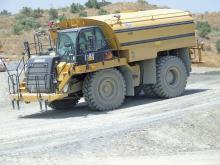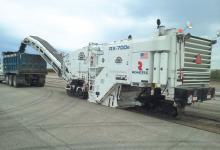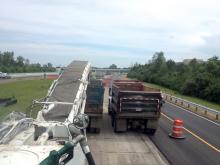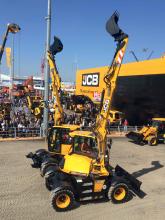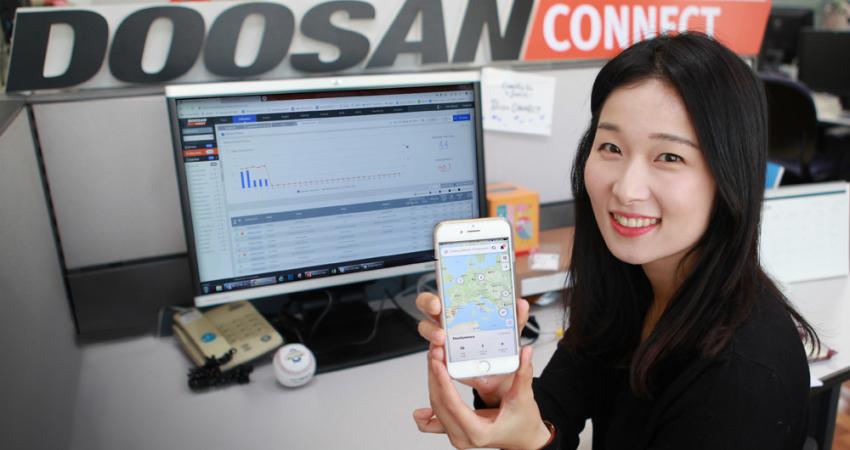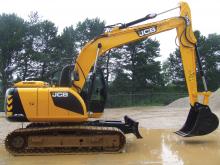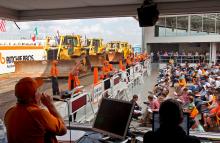Demand for telematics technology is growing, as equipment users begin to lean the value of these systems – Alan Dron reports
With construction projects increasingly operating to wafer-thin profit margins, any technological assistance that can keep the accounts in the black is welcome.
This is particularly the case with those projects where contractors can share a larger slice of the profits if they complete their work ahead of schedule. The downside, of course, is that they also share the pain if the
Using telematics allows equipment users to optimise maintenance schedules
Demand for telematics technology is growing, as equipment users begin to lean the value of these systems – Alan Dron reports
With construction projects increasingly operating to wafer-thin profit margins, any technological assistance that can keep the accounts in the black is welcome.
This is particularly the case with those projects where contractors can share a larger slice of the profits if they complete their work ahead of schedule. The downside, of course, is that they also share the pain if the contract goes awry and incurs losses.
For a decade or more now telematics have been installed in construction vehicles. Today, their presence is not only becoming more widespread, but the information they can gather is becoming increasingly rich and varied. However, is their use based simply on optimising the mechanical productivity of the vehicles, or can the data being gathered really be used to drive behavioural change in personnel? And how much further can information derived from the sensors now routinely placed on construction vehicles be developed?
Today, telematics are increasingly being installed on smaller construction vehicles as well as those at the top of the size range. While they are usually standard on the latter group, they are still classed as options on smaller vehicles by some manufacturers. And in many cases, although the telematics are usually present, they may not always be active. “It’s standard on all our machines, although we don’t activate it as long as the customer doesn’t want it, [as] he has to pay for it,” commented Marc Blondeel, sales promotion coordinator at2300 Komatsu’s European Market Development Department.
178 Caterpillar has installed telematics on some 250,000 vehicles over the past decade, says the company’s marketing and strategy manager, Construction Technology & Solutions Group, John Thomas. Most of their vehicles now come with them factory-installed; some work by cellular communication, others by satellite – something that depends on customer preference and the regulations surrounding radio usage in different countries.
“Any Cat machine can have it added as an option, unless those radio usage regulations prevent it. The company’s medium to large machines such as excavators, graders and trucks have it as standard, the smaller ones, such as backhoe loaders, as an option.”
Caterpillar initially decided to get into the telematics market as a result of impetus from two different sources, says Thomas. “They were added due to a combination of customer ‘pull’ from some of the larger fleet owners, but also as a result of ‘push’ from our internal engineering community, who wanted information to help them to better design future machines.”
Volvo fits the equipment as standard on vehicles of 14tonnes and above and as an option on smaller vehicles, such as compact loaders, noted Martyn Brawn, engineering manager,7659 Volvo Construction Equipment. The telematics on the smaller machines generally send back less information – mainly mapping and tracking functionality – than on larger ones.
Two versions of the company’s CareTrack system – basic and advanced – are fitted. Basic is found in the smaller machines. On larger, more expensive vehicles, there is considerably greater functionality, with owners able to see everything that the OEM sees. The customer gets an initial six-year subscription to view this data, after which a fee is applicable.
255 JCB’s LiveLink telematic fleet management system, meanwhile, is now standard on all of the company’s heavy and mid-range machines.
The functionality of telematics has expanded considerably since the first systems were added more than a decade ago, but certain basic functions are still as valid as ever. Knowing the location and movements of an individual vehicle is still important, but this has expanded into the areas of monitoring machine health and giving warning of potential faults.
Komatsu’s Komtrax system, for example, provides a working record of operational information as well as daily and monthly reports that enable a contractor to monitor machine health and schedule preventative maintenance. It also transmits error codes for problems such as overheating. The daily report shows the machine’s location and working status information from the previous day. It also shows fuel levels and water temperature graphs.
“There is a huge list of items that comes off the machines,” said Caterpillar’s Thomas, “but the key ones are GPS location, number of hours worked and using that to determine preventative maintenance.
“It also measures current fuel levels and the amount of fuel burned over a certain period, the amount of idling time that is occurring, plus fault and event codes.”
Fault codes are generated when the sensors on the engine, transmission and drivetrain detect a pressure or temperature that they feel are indicative of a fault. Event codes are operator-driven – for example, a driver’s action that could cause damage to the machine, such as leaving the parking brake engaged while moving.
Alternatively, a brake over-temperature alarm may indicate that an operator is relying solely on the brakes rather than the machine’s retarders to slow it. That helps a company protect its investment in their equipment – and points out a possible requirement for training or reminding personnel of operating procedures.
However, if a pattern is discerned, such as several vehicles regularly generating braking event codes at certain times, it may indicate that a part of the worksite has excessive slope and requires work to remediate the problem. Many construction vehicles designed to carry payloads will also have weight or counting systems installed to provide data on the amount of material moved or number of trips made each day, measuring this against the amount of fuel burned.
They can also record how long it takes an individual vehicle to make a trip – for example between a quarry’s working face and the crusher. Information can be transmitted to a site office or remote HQ and can also be made available through a web portal to a manager in a remote site, who can pull up the day’s readings on a laptop.
One particular bugbear that can be picked up quickly by telematics, is excessive idling. “If we notice that, we can give that information to the customer and say, ‘Guys, what are you doing with the machines?’” says Komatsu’s Blondeel.
Idling is a habit that many construction companies work hard to curb. Not only is the machine burning fuel without performing useful work, but as vehicle warranties are based on the time an engine is run, idling means that hours of warranty are simply ticking away to no purpose.
“I was demonstrating to a customer last week that they had almost 50% idling time on a machine,” says Volvo’s Brawn. “The customer had a 24/7 operation but at night the machine was just sitting said, engine running. It does very minimal work during the night shift. The clock was being wound up. We’re getting service work from the fact the machine has been doing nothing. It’s good money for us, but it’s not efficient.” Volvo can look at data from its Eco Operator system to determine the quality of an employee’s driving technique. “One of the things we preach is that we use the power and torque in the engine the way it’s designed to be used – it’s not designed to be used flat-out.
We can educate customers and operators into working more efficiently,” said Brawn. While telematics can point out operating problems, they can also be used to make longer-term changes, he adds. “We can certainly make a difference in behaviour with telematics. If the customers want to drill down into it, they can see fairly quickly the situation with the machine – with excessive idling, you’re burning 3-4 litres of fuel an hour.”
Monitoring problems such as idling can be used to modify behaviour in a more subtle, positive way, rather than just bluntly telling staff to curb bad habits, said Caterpillar’s Thomas.
“Customers that are capturing the most value [from telematics] are the ones that are really driving a process change at a site. If a customer has a telematics device on a vehicle and he takes a monthly fuel burn figure, he will get a certain amount of value from that.
But some people do it weekly, or even daily.” They may post the results in break rooms and tell staff, for example, that the driver with the lowest idling time over the course of a month will get a gift voucher for a local restaurant. That gives personnel an incentive and, as a result, they are more likely to change their behaviour of their own volition.
The destination of data produced by the on-board telematics varies. Some manufacturers will send it direct to owners, or make it available via a web portal. Others will either transmit it to the dealers who sold the vehicle or keep it themselves. In both the latter cases, the vehicle owners will normally have the option to view this, but may have to pay a fee to do so.
Volvo, for example, makes certain parameters from its Machine Tracking and Information System freely available to customers. Users can see some data, but have to subscribe to software to see all the available information. Not many do, according to Brawn.
Typically, the manufacturer will offer an initial no-cost period but introduce a charge after a certain number of years, in the hope that the owners has by then appreciated the value of the information. This can be integrated into many common fleet management software packages.
Dealers who have access to the data can schedule planned maintenance and offer advice if one or more machines is returning fault codes or poorer than average performance. Main areas of interest for many owners are fuel consumption, CO₂ emissions and travel times between work areas. In JCB’s case, electronic cautions – if water is detected in a fuel tank, for instance – can be sent to both the owner and the local dealer. This allows action to be taken to prevent damage to the machine. Traditionally, the sheer size of many construction vehicles was no deterrent to them being stolen. The installation of sensors such as GPS may not remove the risk of theft, but certainly make it easier to track down if it disappears.
Owners now have the capability to set ‘geo-fences’ or ‘time fences’ on telematics-equipped vehicles, switching off the engine and alerting the owner if it leaves a predetermined area or preventing it from being switched on outside certain hours, such as over a weekend when a worksite is deserted.
With time fences, while a machine may not shut down automatically at the start of the time-barred period, once it is shut down, it will not be able to be restarted until the curfew ends. Even these precautions may not be a deterrent to thieves removing a vehicle, perhaps by lifting it on to a trailer without starting its engine. “It won’t prevent theft but there have been numerous occasions where it’s helped us recover a machine,” said Thomas. “We can go on the map and say ‘It’s here.’ Usually the equipment is large enough that it’s difficult to hide!”
Similarly,233 Hitachi’s tracking and E-Guard systems will alert the owner if the vehicle is loaded on to a truck even without the engine being switched on, with its position being transmitted every 5km. “We had one case of tracking a machine to the Polish border after it had been stolen in Germany,” recalled Hitachi service development engineer Yemi Onabiyi.
Features such as JCB’s LiveLink location system can also alert rental companies to continued use of equipment that has supposedly completed its hire period. If a machine comes to the end of its rental period too late on a Friday afternoon to be returned to the plant hire company, for example, it is not unknown for it to be clandestinely hired out to a third party for profit while nominally off-hire and awaiting collection the following Monday. Having systems such as LiveLink on a machine can also lead to reduced insurance premiums, as it is integrated with the machine’s immobiliser.
LiveLink can be paired with the machine’s electronic control unit (ECU) – on JCB’s Load-all telescopic handler range, for example. If the LiveLink system is disabled, prior to an attempted theft of the machine, the ECU will prevent the machine from starting. This system is due to be expanded to other JCB machines.
Telematics in the construction vehicle sector will only become more comprehensive, their manufacturers believe. “I think machines are going to get smarter and smarter in the future and we are going to see more information coming off them,” said Thomas. “There are a couple of reasons for this: the machines will have more sensors and collect more information. Additionally, more information can be compressed into available bandwidth.” The company’s engineers would find more ways to make use of that added capacity. “I think the challenging thing for our customers is how we present that to them, so it’s useful and actionable and not just completely overwhelming.
“A lot of information that comes off our machines today is focused on machine health. We’re seeing customers ask more and more how they remotely track productivity.” Volvo’s Brawn agreed on the likely future quantities of data produced. Where the company’s telematics today report on 40-50 parameters, which could easily be expanded to three or four times that figure with a bolt-on package.
Due to be introduced, for example, is a weighing system on articulated dump trucks that will show customers how productive their machines are.
Manufacturers such as Hitachi are constantly asking dealers and customers for feedback on their experience with the on-board telematics and what they would like to have improved. Over the years this has been increasingly used to customise the system to reflect users’ needs, a trend likely to continue.
With more than 57,000 machines currently registered and tens of thousands of users regularly logging on to use LiveLink, the system already fundamental to many businesses, says JCB spokesman Ben Brookes.
The company is constantly extending the functionality of LiveLink and will soon be offering remote PIN code services. This will permit fleet managers to remotely set the immobiliser PIN for different operators and levels of access to the machine, further raising security. This, too, will prevent hire customers from continuing to utilise equipment that has been declared off-hire, as the rental company will be able to change the access PIN code once the machine has been securely parked.
With construction projects increasingly operating to wafer-thin profit margins, any technological assistance that can keep the accounts in the black is welcome.
This is particularly the case with those projects where contractors can share a larger slice of the profits if they complete their work ahead of schedule. The downside, of course, is that they also share the pain if the contract goes awry and incurs losses.
For a decade or more now telematics have been installed in construction vehicles. Today, their presence is not only becoming more widespread, but the information they can gather is becoming increasingly rich and varied. However, is their use based simply on optimising the mechanical productivity of the vehicles, or can the data being gathered really be used to drive behavioural change in personnel? And how much further can information derived from the sensors now routinely placed on construction vehicles be developed?
Today, telematics are increasingly being installed on smaller construction vehicles as well as those at the top of the size range. While they are usually standard on the latter group, they are still classed as options on smaller vehicles by some manufacturers. And in many cases, although the telematics are usually present, they may not always be active. “It’s standard on all our machines, although we don’t activate it as long as the customer doesn’t want it, [as] he has to pay for it,” commented Marc Blondeel, sales promotion coordinator at
“Any Cat machine can have it added as an option, unless those radio usage regulations prevent it. The company’s medium to large machines such as excavators, graders and trucks have it as standard, the smaller ones, such as backhoe loaders, as an option.”
Caterpillar initially decided to get into the telematics market as a result of impetus from two different sources, says Thomas. “They were added due to a combination of customer ‘pull’ from some of the larger fleet owners, but also as a result of ‘push’ from our internal engineering community, who wanted information to help them to better design future machines.”
Volvo fits the equipment as standard on vehicles of 14tonnes and above and as an option on smaller vehicles, such as compact loaders, noted Martyn Brawn, engineering manager,
Two versions of the company’s CareTrack system – basic and advanced – are fitted. Basic is found in the smaller machines. On larger, more expensive vehicles, there is considerably greater functionality, with owners able to see everything that the OEM sees. The customer gets an initial six-year subscription to view this data, after which a fee is applicable.
The functionality of telematics has expanded considerably since the first systems were added more than a decade ago, but certain basic functions are still as valid as ever. Knowing the location and movements of an individual vehicle is still important, but this has expanded into the areas of monitoring machine health and giving warning of potential faults.
Komatsu’s Komtrax system, for example, provides a working record of operational information as well as daily and monthly reports that enable a contractor to monitor machine health and schedule preventative maintenance. It also transmits error codes for problems such as overheating. The daily report shows the machine’s location and working status information from the previous day. It also shows fuel levels and water temperature graphs.
“There is a huge list of items that comes off the machines,” said Caterpillar’s Thomas, “but the key ones are GPS location, number of hours worked and using that to determine preventative maintenance.
“It also measures current fuel levels and the amount of fuel burned over a certain period, the amount of idling time that is occurring, plus fault and event codes.”
Fault codes are generated when the sensors on the engine, transmission and drivetrain detect a pressure or temperature that they feel are indicative of a fault. Event codes are operator-driven – for example, a driver’s action that could cause damage to the machine, such as leaving the parking brake engaged while moving.
Alternatively, a brake over-temperature alarm may indicate that an operator is relying solely on the brakes rather than the machine’s retarders to slow it. That helps a company protect its investment in their equipment – and points out a possible requirement for training or reminding personnel of operating procedures.
However, if a pattern is discerned, such as several vehicles regularly generating braking event codes at certain times, it may indicate that a part of the worksite has excessive slope and requires work to remediate the problem. Many construction vehicles designed to carry payloads will also have weight or counting systems installed to provide data on the amount of material moved or number of trips made each day, measuring this against the amount of fuel burned.
They can also record how long it takes an individual vehicle to make a trip – for example between a quarry’s working face and the crusher. Information can be transmitted to a site office or remote HQ and can also be made available through a web portal to a manager in a remote site, who can pull up the day’s readings on a laptop.
One particular bugbear that can be picked up quickly by telematics, is excessive idling. “If we notice that, we can give that information to the customer and say, ‘Guys, what are you doing with the machines?’” says Komatsu’s Blondeel.
Idling is a habit that many construction companies work hard to curb. Not only is the machine burning fuel without performing useful work, but as vehicle warranties are based on the time an engine is run, idling means that hours of warranty are simply ticking away to no purpose.
“I was demonstrating to a customer last week that they had almost 50% idling time on a machine,” says Volvo’s Brawn. “The customer had a 24/7 operation but at night the machine was just sitting said, engine running. It does very minimal work during the night shift. The clock was being wound up. We’re getting service work from the fact the machine has been doing nothing. It’s good money for us, but it’s not efficient.” Volvo can look at data from its Eco Operator system to determine the quality of an employee’s driving technique. “One of the things we preach is that we use the power and torque in the engine the way it’s designed to be used – it’s not designed to be used flat-out.
We can educate customers and operators into working more efficiently,” said Brawn. While telematics can point out operating problems, they can also be used to make longer-term changes, he adds. “We can certainly make a difference in behaviour with telematics. If the customers want to drill down into it, they can see fairly quickly the situation with the machine – with excessive idling, you’re burning 3-4 litres of fuel an hour.”
Monitoring problems such as idling can be used to modify behaviour in a more subtle, positive way, rather than just bluntly telling staff to curb bad habits, said Caterpillar’s Thomas.
“Customers that are capturing the most value [from telematics] are the ones that are really driving a process change at a site. If a customer has a telematics device on a vehicle and he takes a monthly fuel burn figure, he will get a certain amount of value from that.
But some people do it weekly, or even daily.” They may post the results in break rooms and tell staff, for example, that the driver with the lowest idling time over the course of a month will get a gift voucher for a local restaurant. That gives personnel an incentive and, as a result, they are more likely to change their behaviour of their own volition.
The destination of data produced by the on-board telematics varies. Some manufacturers will send it direct to owners, or make it available via a web portal. Others will either transmit it to the dealers who sold the vehicle or keep it themselves. In both the latter cases, the vehicle owners will normally have the option to view this, but may have to pay a fee to do so.
Volvo, for example, makes certain parameters from its Machine Tracking and Information System freely available to customers. Users can see some data, but have to subscribe to software to see all the available information. Not many do, according to Brawn.
Typically, the manufacturer will offer an initial no-cost period but introduce a charge after a certain number of years, in the hope that the owners has by then appreciated the value of the information. This can be integrated into many common fleet management software packages.
Dealers who have access to the data can schedule planned maintenance and offer advice if one or more machines is returning fault codes or poorer than average performance. Main areas of interest for many owners are fuel consumption, CO₂ emissions and travel times between work areas. In JCB’s case, electronic cautions – if water is detected in a fuel tank, for instance – can be sent to both the owner and the local dealer. This allows action to be taken to prevent damage to the machine. Traditionally, the sheer size of many construction vehicles was no deterrent to them being stolen. The installation of sensors such as GPS may not remove the risk of theft, but certainly make it easier to track down if it disappears.
Owners now have the capability to set ‘geo-fences’ or ‘time fences’ on telematics-equipped vehicles, switching off the engine and alerting the owner if it leaves a predetermined area or preventing it from being switched on outside certain hours, such as over a weekend when a worksite is deserted.
With time fences, while a machine may not shut down automatically at the start of the time-barred period, once it is shut down, it will not be able to be restarted until the curfew ends. Even these precautions may not be a deterrent to thieves removing a vehicle, perhaps by lifting it on to a trailer without starting its engine. “It won’t prevent theft but there have been numerous occasions where it’s helped us recover a machine,” said Thomas. “We can go on the map and say ‘It’s here.’ Usually the equipment is large enough that it’s difficult to hide!”
Similarly,
Features such as JCB’s LiveLink location system can also alert rental companies to continued use of equipment that has supposedly completed its hire period. If a machine comes to the end of its rental period too late on a Friday afternoon to be returned to the plant hire company, for example, it is not unknown for it to be clandestinely hired out to a third party for profit while nominally off-hire and awaiting collection the following Monday. Having systems such as LiveLink on a machine can also lead to reduced insurance premiums, as it is integrated with the machine’s immobiliser.
LiveLink can be paired with the machine’s electronic control unit (ECU) – on JCB’s Load-all telescopic handler range, for example. If the LiveLink system is disabled, prior to an attempted theft of the machine, the ECU will prevent the machine from starting. This system is due to be expanded to other JCB machines.
Telematics in the construction vehicle sector will only become more comprehensive, their manufacturers believe. “I think machines are going to get smarter and smarter in the future and we are going to see more information coming off them,” said Thomas. “There are a couple of reasons for this: the machines will have more sensors and collect more information. Additionally, more information can be compressed into available bandwidth.” The company’s engineers would find more ways to make use of that added capacity. “I think the challenging thing for our customers is how we present that to them, so it’s useful and actionable and not just completely overwhelming.
“A lot of information that comes off our machines today is focused on machine health. We’re seeing customers ask more and more how they remotely track productivity.” Volvo’s Brawn agreed on the likely future quantities of data produced. Where the company’s telematics today report on 40-50 parameters, which could easily be expanded to three or four times that figure with a bolt-on package.
Due to be introduced, for example, is a weighing system on articulated dump trucks that will show customers how productive their machines are.
Manufacturers such as Hitachi are constantly asking dealers and customers for feedback on their experience with the on-board telematics and what they would like to have improved. Over the years this has been increasingly used to customise the system to reflect users’ needs, a trend likely to continue.
With more than 57,000 machines currently registered and tens of thousands of users regularly logging on to use LiveLink, the system already fundamental to many businesses, says JCB spokesman Ben Brookes.
The company is constantly extending the functionality of LiveLink and will soon be offering remote PIN code services. This will permit fleet managers to remotely set the immobiliser PIN for different operators and levels of access to the machine, further raising security. This, too, will prevent hire customers from continuing to utilise equipment that has been declared off-hire, as the rental company will be able to change the access PIN code once the machine has been securely parked.

